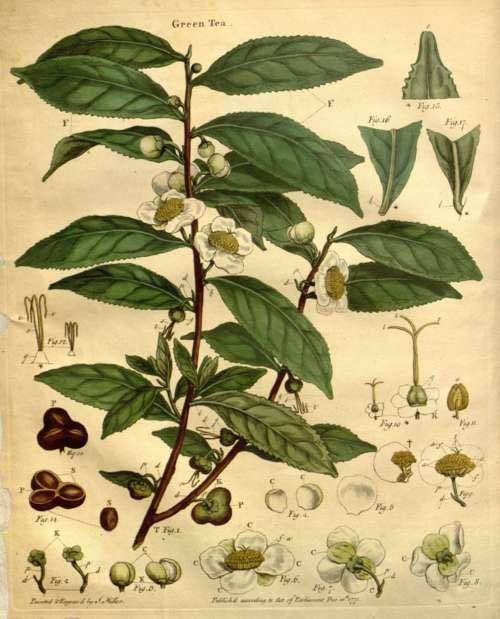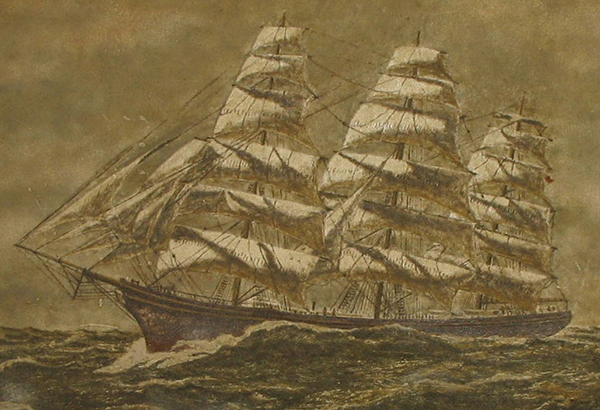Timeline
1537 — Portugal starts trading with China
1558 — Queen Elizabeth I reign begins
 Source: William Ukers
Source: William Ukers 1600 — Queen Elizabeth I granted a Royal Charter to the British East India Company
1606 — Tea is transported from Macao, China by the Dutch
1615 — A letter from an English gentleman contains the first reference to tea
1637 — Tea comes into common use in Holland
1650 — Still used only occasionally in England, tea ranges from £6 to £10 per pound
1650 — Dutch introduce tea to New Amsterdam (New York)
1658 — First advertisements of tea in a newspaper appear in London
1659 — London newspaper records that tea, coffee, and chocolate are sold "almost in every street" such as the shops in the famous Exchange Alley section of London (see map to the right)
 Source: William Ukers
Source: William Ukers 1660 — First English law placing tax on every gallon of tea
1664 — East India Company presents 2 lbs. 2 oz. of tea to King Charles II to entice him into renewing charter
1666 — Tea made fashionable within aristocracy when Lords Arlington and Ossory present tea as gifts
1669 — East India Company makes first direct importation of tea, of 143 pounds
1669 — Tea imports from Holland prohibited by law, removing the Dutch East India Company as competition
1672 — London market gluttoned when East India Company import 4717 pounds of tea
1680 — Duchess of York begins serving tea in Scotland
1680 — Tea advertised for 30 shillings a pound
1680 — France is introduced to taking tea with milk
1689 — First direct imports from China arrive in London
1700 — American colonies begin taking tea with milk
1700 — Grocers begin to sell tea, previously available only in coffee houses or from apothecaries
1721 — Tea imports into England exceed one million pounds
1721 — Imports of tea from all parts of Europe prohibited, completing East India Company's monopoly on tea into England
1725 — First law prohibiting tea adulteration
1730 — Second law prohibiting tea adulteration
1739 — Tea leads value of all imports into Holland for the first time
1749 — London made a free port for teas bound for Ireland and America
1750 — Black tea becoming more popular in Holland than green tea; England soon followed
1750 — English become very interested in exploration and the quest for botanical knowledge
1750 — New, organized mode of smuggling outpaces sales of legal tea
1753 — Swedish botanist, Carl Linnaeus, first classifies tea, but incorrectly into genera, as Thea sinensis and Camellia sinensis
 Source: scientificillustration.tumblr.com
Source: scientificillustration.tumblr.com 1753 — Wide use of tea in rural districts of England
1766 — Penalty for adulterating tea includes imprisonment
1767 — England imposes tax on tea imported to American colonies
1770 — Tea used in American colonies bootlegged from Holland to avoid tax
1773 — East India Company ships full of tea bound for Boston and other American cities
1776 — American Revolution results from the enforcement of tea duty on colonists
1779 — English law compels shopkeepers selling tea to identify their shop by signage
1784 — Tea merchants begin campaigning hard against smuggled tea
1784 — Parliament passes Commutation Act, reducing tax on tea to 12.5%
1785 — 30,000 wholesales and retailers register as tea dealers in England
1788 — England begins considering growing tea in British India
1791 — Start of a decade of the East India Company importing an average of 3,300,000 pounds of tea
1802 — Reported failure of attempts to grow tea in Ceylon (Sri Lanka)
1813 — Parliament ends East India Company's monopoly of India trade, but not its China tea trade
1818 — Britain controlled most of India
1820 — Indian-grown opium sales to China begin increasing, from 10,000 to 100,000 cases, annually
1825 — London Society for Fine Arts offers a gold medal for the first tea grown on British soil
 Source: commons.wikimedia.org
Source: commons.wikimedia.org 1832 — First clipper ships for tea trade are built in America
1833 — Parliament abolished the East India Company monopoly of China tea trade
1834 — First tea committee formed, to find land within India to grow tea
1834 — First tea sale held after East India Company monopoly ended
1838 — First shipment of native Assam tea sent to London
1839 — First Opium War with China begins
1840 — Second shipment of Assam tea arrives in London
1842 — As post-war concessions, new Chinese ports open up to trade with the west
1842 — First writings of "afternoon tea"
1848 — East India Company sends Robert Fortune to China, to seal tea seeds and plants to replant in India
1850 — First American clipper ship brings Chinese tea to London in record time
1850 — Women began taking tea in each others' homes
1854 — English patents are issued for tea-making devices
1856 — Tea cultivation begins in additional regions of India
1856 — Second Opium War with China begins
 Source: William Ukers
Source: William Ukers 1857 — Raj rule (British Crown rule) begins in India after Indian Mutiny and lasts until 1947
1858 — United States sends Robert Fortune to China for tea seeds and plants to be planted in the American south
1860 — Indian-grown tea begins replacing Chinese-grown tea throughout Britain
1866 — Sensational tea race of eleven tea clippers from Foochow to London is won by the "Ariel" in 99 days
1866 — Imports of Chinese tea: 97 million pounds, and Indian tea: 4 million pounds
1869 — Suez Canal opens giving steam-powered ships speed advantage over tea clippers
1870 — Tea plantations thriving in India, despite increase in supply
1886 — Chinese tea trade peaks, worldwide
1889 — Royalty and aristocracy begin giving gifts of ornamental boxes of Indian and Ceylon tea
1891 — Record price for Ceylon-grown tea at London auction for £25 per pound
1896 — Indian and Ceylon teas advertised in United States
1898 — Ceylon teas advertised in Africa

